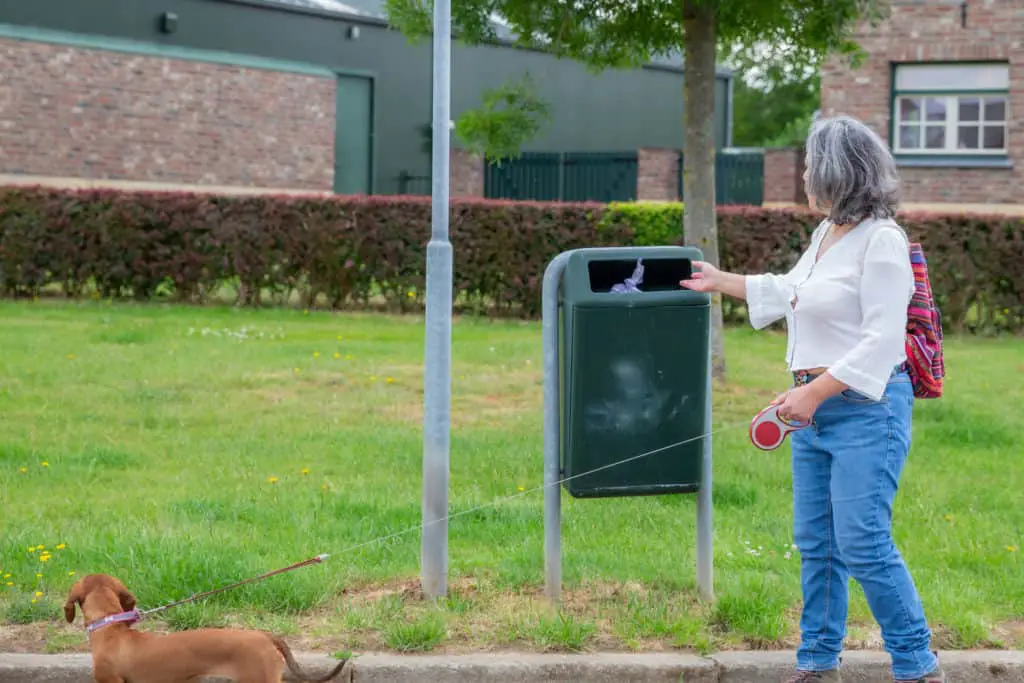Your mobile phone and number give away a lot of your information. Since your smartphone is always with you, a disposable or burner phone with a temporary phone number may help reduce how easily you can be traced, but is it really that effective?
Generally, a burner phone can be tracked. All mobile phones and burner apps go through a cellular carrier or virtual number operator. Your identity can be tracked via call logs, data usage, location, and text messages. Law enforcement can compel companies to provide this information.
The average person might want a burner phone to add a layer of privacy. But, being completely untraceable is not easily accomplished and here’s why…

Can Burner Phones Be Tracked: Quick Breakdown
Burner phones can be tracked using cell tower triangulation. Like all cellular devices, burner phones connect to a cellular network by measuring the signal strength from several towers. The phone’s location can be determined based on its distance from each tower.
Additionally, the various radios like Wi-Fi and Bluetooth in your smartphone further enhance the ability to track a device, be it a burner or not.
It should go without saying that if the GPS functionality or location services is active, location is even more accurate.
The anonymity of a burner phone stems from the lack of a contract or user information tied to it. While authorities can locate the phone, associating it with a particular individual is more challenging.
Changing the SIM card or updating the eSIM can temporarily make a burner phone harder to track, as it changes the subscriber identification, but again, the location can be traced even if identifying the holder is harder.
Airplane mode, turning off the device, or putting your cell phone in a Faraday bag can halt real-time tracking, but remember, it doesn’t erase past location records logged when the phone was active.
Authorities have tools like Stingrays or international mobile subscriber identity (IMSI) catchers to simulate a mobile cell tower, compelling nearby mobile devices to connect to it, and enabling the tracking and locating of burner phones.
Some newer burner phones come with advanced security features like physical switches to turn off radio components and advanced MAC address rotation, making consistent tracking more difficult.
For those curious about Tracfones and other prepaid options, let’s delve into how they compare to burner phones in terms of traceability.
Can a Tracfone Be Traced: Specifics on Prepaid Phones
Tracfones are a brand of prepaid phone with many of the same features similar to regular smartphones. They can be located through cell tower triangulation and onboard radios.
Unlike contract-based phones, Tracfones and other prepaid options present a challenge to trace due to the absence of a long-term contract with personal identification details.
The IMEI number of the phone is a unique identifier that can be used to trace its physical location, providing a reliable means for law enforcement to track a device if necessary.
Emergency 911 calls are always traceable, regardless of whether you’re using a prepaid Tracfone, ensuring a quick and accurate response by emergency services. National laws often require this capability for emergency responders.
Upon activating a Tracfone, there’s generally no requirement to provide personal identification, although some retailers might ask for ID due to store policies or local regulations.
Some Tracfone models have removable batteries. Disconnecting the power source prevents the phone from being traced, albeit at the cost of rendering the phone unusable.
With a clear understanding of how prepaid phones like Tracfones can be traced, let’s move on to the legal implications surrounding the use of burner phones.

Are Burner Phones Illegal: Legal Implications and Uses
Owning a burner phone is largely legal in most jurisdictions. They are simply prepaid mobile devices sans a long-term contract.
However, the legal stance shifts if the phone is used for illegal activities like fraud, drug trafficking, or any form of criminal communication.
In some countries, identification is required when purchasing any type of mobile phone, including burner phones. This regulation aims to record who owns which device, discouraging the use of phones for illicit activities.
Law enforcement agencies often monitor bulk purchases of burner phones. Acquiring many burner phones at once can raise red flags, potentially prompting further investigation.
Burner phones can also serve ethical and legal purposes, such as whistleblowing. Depending on the jurisdiction and the circumstances, utilizing a burner phone to expose wrongdoing can be entirely lawful.
Let’s transition to another curiosity – tracing a phone number back to its owner.
Can I Find Out Who a Phone Number Belongs To? Tools and Methods
Reverse phone lookup services are a great starting point. Websites like Spokeo or BeenVerified allow you to input a phone number to unearth its owner. However, the provided details might be limited or outdated.
Mobile carriers might also offer number identification services, such as T-Mobile’s Scam Shield or AT&T’s Call Protect, although they may not be comprehensive.
For formal identification, law enforcement agencies can request this information from mobile carriers, albeit typically in the context of an investigation.
There are also free online tools claiming to identify phone numbers, but their accuracy and completeness can be hit or miss, so exercise caution.
Social media platforms like Facebook allow phone number-based searches for individuals, provided the person has linked their number to their profile and set it to public.
Public records databases can sometimes yield results, especially with landline numbers. Specialized public records websites can assist, though the information may not be up-to-date.
Next, let’s debunk some common myths about locating a phone number’s location using free online tools.

Type in Phone Number and Find Location Free Online: Reality Check
Numerous online services claim to offer free tracking, but often, they are inaccurate or misleading. While they might provide a general area, accurate data is usually unattainable.
Tracking someone’s location without proper authorization is generally illegal. Ensure you have consent from the person you’re trying to locate to avoid venturing into unlawful territory.
Only law enforcement agencies possess the legal authority to request real-time location tracking, compelling service providers to furnish accurate, real-time location data.
Be wary of phishing websites claiming to offer free tracking services. They might aim to collect your personal information or install malicious software on your device.
Some apps promise to track a phone’s location just by entering its number, but they typically require installation on the target phone, which is impractical without the other person’s consent.
Lastly, be cautious with tracking services advertised as “free.” Hidden fees or subscriptions might be unveiled only after you’ve used the service. Always peruse the fine print to evade unexpected costs.
Now, let’s shift our focus to how apps like Signal and WhatsApp are revolutionizing secure and ephemeral communication.
The Rise of Ephemeral Communication: Signal and WhatsApp
End-to-end encryption is a hallmark of ephemeral communication platforms like Signal and WhatsApp. This feature ensures that only the communicating parties can read the messages, thwarting potential eavesdroppers.
Both apps introduce self-destructing messages, which are automatically deleted post-viewing, amplifying privacy measures.
Signal is notable for its minimal data collection, abstaining from storing metadata, hence leaving far less information of who communicated with whom and when. This stance makes tracing message history challenging.
On the flip side, WhatsApp is owned by Facebook, whose data privacy track record is less than stellar. This ownership might raise concerns regarding data usage and access.
Despite robust encryption, these platforms are not entirely anonymous. User information like phone numbers is still stored and can be subject to legal requests.
In the quest for privacy, Signal emerges as a safer option. For more casual or widespread use, WhatsApp is more universally recognized, though with a trade-off in potential data sharing with Facebook.
There are some ways to increase the privacy when purchasing a secondary device and phone number.
How To Get and Use a Burner Phone CORRECTLY
The following guidelines provide an average level of privacy for getting and using a burner phone and number. You’re free to increase or decrease your operational hygiene.
For example, you can be more cautious by having a friend buy a phone and dispose of it by leaving it active on public transit. For less sensitive situations, you might decide it’s okay to buy a temporary phone with a credit card and later recycle it. You choose.

Buying It
- Go to a mobile phone or convenience store instead of a “big box” electronics or grocery store.
- Buy a new device with as many voice minutes, texts, and data as you’ll need in one purchase.
- Choose a dumb phone over an Android smartphone or iPhone.
- Prepaid phone plans only. We do not want a phone bill.
- Choose an area code nearby, hopefully in a large city.
- Use cash or cryptocurrency and refuse/do not touch a receipt.
Refilling or topping up prepaid minutes on a burner phone is a perfect situation for cryptocurrency. Several services, like Bitrefill, accept cryptocurrency. - Consider your obligations to provide completely accurate information at the time of purchase if your locale requires it.
- Act casually, wear average clothing, and look like every other customer.
- Activate the phone and SIM card after 1–2 days in a residential area away from your own, preferably near an apartment or crowded neighborhood.
- Leave the default, generic, outbound voicemail greeting. Don’t change or customize it.

Using It
We previously showed you that your phone’s location is constantly being tracked. Here’s how to use a burner phone more securely.
- Answer phone calls away from your residence and workplace and only if necessary. It’s better to…
- Return calls from random locations and varying callback times and lengths.
- Avoid carrying your backup and personal phones at the same time.
- Make additional, random, unrelated calls of varying lengths to businesses and individuals in and outside your area code.
- Send a few text messages to numbers in and out of your area, whether you know the recipient or not.
- Severely limit providing this secondary phone number online, if at all.
- Use this temporary phone and SIM for as short a period as feasible.
- Never send standard texts with real or private information.
If you need to send truly private texts, use our guide on sending disappearing messages that self-destruct or expire.

Disposing of It
- Remove and dispose of the SIM chip separately when an eSIM is not in use.
- Rough up the phone’s edges and casing, or break the screen. Water damage is a practical option.
- Remove the battery if possible, or wrap the phone in aluminum foil.
- Place it in a fast-food bag and crumple it.
- Throw the bag into a public trash can that many people use and is changed often.
- Alternatively, you can keep the phone active but leave it “accidentally” on public transit.
Again, consider this a baseline protocol that can be built upon or loosened depending on your personal situation.
Other Questions You Might Have
How do I obtain a burner phone?
Burner phones can be purchased at various retail stores or online platforms. They are usually inexpensive and come with a set amount of prepaid minutes.
What are some other methods law enforcement might use to track phones?
Besides cell tower triangulation and GPS tracking, law enforcement may use methods like analyzing call detail records, utilizing malware, or leveraging international mobile subscriber identity (IMSI) catchers like Stingrays to track phones.
What are the specific laws regarding phone tracking?
Laws regarding phone tracking vary by country and state, and typically revolve around issues of privacy, consent, and legal authority. It’s advisable to consult local laws or legal counsel to understand the specific regulations pertaining to phone tracking in your area.
Can burner phones be used internationally?
Yes, burner phones can be used internationally, though it depends on the network compatibility and roaming capabilities of the specific phone. It’s advisable to check the phone’s specifications and the carrier’s international plans or services before traveling.
Are there any apps specifically designed to make burner phones more secure?
Yes, there are apps designed to enhance the security and privacy of burner phones. Apps like Signal or other encryption-based applications can help obscure your identity and data, making tracking more difficult.
